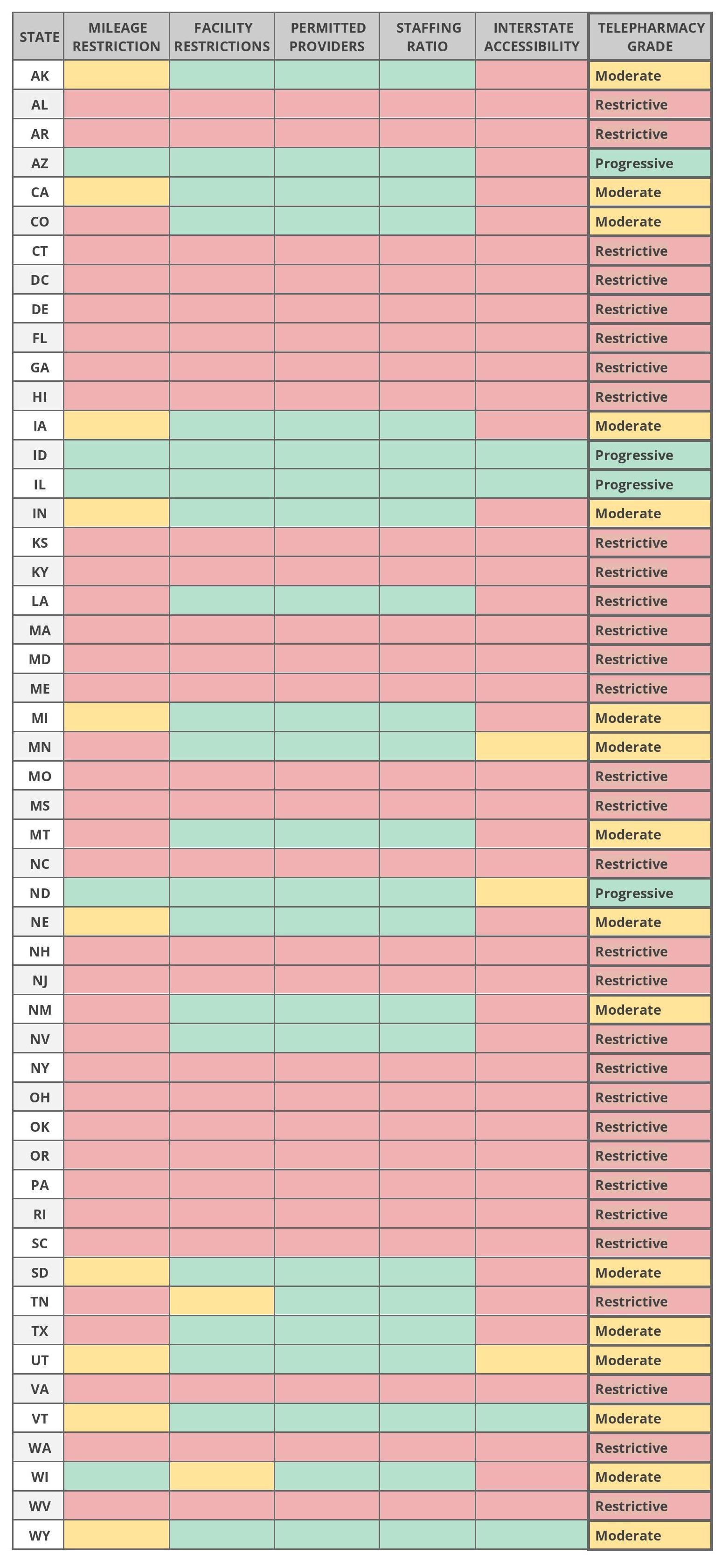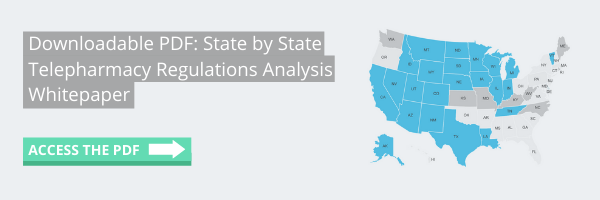Grading each state’s telepharmacy regulations.
Want the PDF version of this whitepaper? Click below! See our updated 2023 white paper here.
INTRODUCTION
Telepharmacy, defined as “the delivery of pharmaceutical care via telecommunications to patients at a distance,” has been practiced in the United States since 2001. As of April 2020, 28 states have implemented regulations permitting the practice of telepharmacy in order to expand pharmacy services to underserved areas. Telepharmacy is becoming more widespread as the safety and benefits of the practice are realized, and many of the 22 states that do not permit the practice today look to implement favorable telepharmacy language in the near future.
Telepharmacy is akin to telehealth, defined as “the distribution of health-related services and information via telecommunications.” Telepharmacy and telehealth both aim to provide convenient health services to patients using technology. However, telehealth is permitted in some form in all 50 states today, whereas telepharmacy is not yet.
Although telehealth is widespread and telepharmacy has been proven to benefit pharmacies and patients across the country, regulations for both practices are still restrictive in many states. Not only are the regulations restrictive, but they also vary from state to state. This disparate state by state approach is conveyed in greater detail on this telehealth regulations map from the Center for Connected Health Policy, and on this telepharmacy regulations map from TelePharm.
The following analysis examines five key areas of telepharmacy regulations across all 50 states and provides an overall rating for the state based on those key areas. The grading table is adapted from this 2018 survey by Manatt Health, which analyzes regulations for telehealth generally and related to Medicaid.
State regulations were analyzed and rated based on the following scale:
- Restrictive = State laws and regulations are restrictive and inhibit the broad use of telepharmacy.
- Moderate = State laws and regulations are mixed and/or moderately support the broad use of telepharmacy.
- Progressive = State laws and regulations enable the broad use of telepharmacy.
KEY FINDINGS
Five key areas of telepharmacy regulations were analyzed in each state and are identified in the table below.
- Mileage restriction: Of the states permitting telepharmacy, 10 have moderate restrictions on mileage. These restrictions include provisions such as maintaining a 10+ mile radius between the telepharmacy and the nearest traditional pharmacy. Another 7 states have restrictive mileage regulations of 20+ miles, severely limiting opportunities for access. States including Arizona, Illinois and Idaho have no mileage restrictions and have continued to maintain the safety and integrity of the profession while providing pharmacy access within outpatient clinics. When regulations are progressive, i.e. no mileage restriction, pharmacists are able to provide convenient pharmacy access to patients across the state without unnecessary barriers to their provision of care.
- Facility restrictions: Facility requirements for a telepharmacy are generally the same as in a traditional pharmacy. Some states include provisions such as requiring the telepharmacy site to be within a certain distance from the host site or requiring minimum square footage. Two states permitting telepharmacy require the telepharmacy to be located within a clinic or FQHC, other states allow the telepharmacy to operate as a brick and mortar pharmacy.
- Permitted providers: Typical telepharmacy regulations include permitted provider restrictions similar to a traditional pharmacy, which include requiring oversight from a licensed pharmacist and requiring pharmacy technician(s) to be certified and/or meet experience hour requirements.
- Staffing ratio: Two states (ID and VT) have no staffing ratio requirement, but most states place parameters on the number of technicians a supervising pharmacist may oversee at one time. The pharmacist-technician ratio ranges from 1:2 to 1:6, depending on the state.
- Interstate accessibility: A few states, such as Illinois, allow interstate accessibility for telepharmacy. The remaining states require the telepharmacy and host pharmacy to be located and licensed within the same state.
50 state analysis of telepharmacy regulations - April 2020

CONCLUSION
As of April 2020, in 32 of 50 states the overall telepharmacy regulations grade is restrictive, and only four states employ progressive regulations. Although telepharmacy is technically permitted in 24 states, eight of the 24 states have restrictive regulations in place that inhibit the practice on a broad scale.
Telepharmacy will become an even more vital practice in the coming years as pharmacists and pharmacy owners search for safe and effective ways to expand their patient reach, remain financially viable amid external threats to their industry and businesses, and provide essential pharmacy services to their community. The information in this analysis is meant to educate key stakeholders about the current state of telepharmacy regulations and serve as a baseline for marking the progress of more progressive telepharmacy regulations to come.
Note: Telepharmacy in this analysis refers to remote dispensing and remote counseling in an outpatient or retail setting.
Curious to learn more about the current state of telepharmacy regulations? Click below to watch our recent webinar, hosted by pharmacists and regulatory experts Adam Chesler and Jessica Adams:
Want to just learn more about how telepharmacy works and the impact it can have on your pharmacy and patients? Click below to watch a short informational video:




